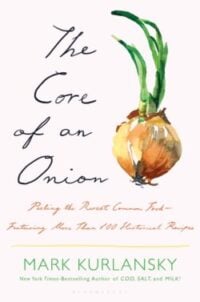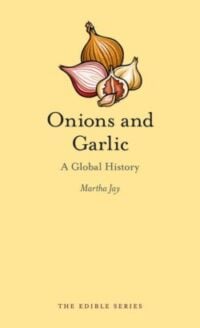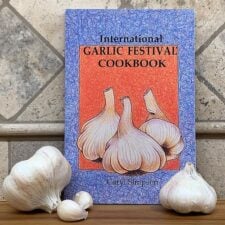7 books about onions, garlic and the wide world of alliums
“In much of the world, from Asia to the Mediterranean, the first step in cooking is often to chop an onion and have a good cry.”
So writes Mark Kurlansky in the introduction to his latest work of culinary history: “The Core of an Onion,” published in late 2023. Kurlansky is known for his bestselling single-subject volumes, each diving deep into one ingredient to tell a broader human story. There’s “Cod” — for which wars have been fought and continents, colonized — and his follow-up fish book, “Salmon.” His book on oysters explores how the once-bountiful bivalve shaped the history of New York City. He’s written about salt, so essential that it’s the only rock humans commonly eat, and milk, which helped drive the domestication of animals and, later, the rise of industrial animal agriculture. These are ingredients that have supported ecosystems, driven world trade, mirrored shifts in humans’ relationship with the natural world. Why would the humble onion deserve the same attention?
It’s true that onions and their relatives tend to be background players or pigeonholed in the realm of garnish and condiment. But the story of onions is rich and often surprising — and of course, for many of us, it’s hard to imagine cooking without them. The same can be said for any of the alliums: the group of aromatic vegetables (in the genus Allium) that includes garlic, leeks, chives, scallions, shallots, ramps and many other pungent bulbs and stalks. Each has been crucial to cuisines around the world for millennia, if not longer. Each has its own nuances despite the sometimes in-your-face flavor. And each can easily, with the right recipe and mindset, become the star of a show-stopping dish.
Kurlansky isn’t the only author over the decades who has endeavored to give onions and their relatives the respect they deserve. We rounded up a few favorite books that are all about alliums — keep reading for the full list.
The Core of an Onion: Peeling the Rarest Common Food

by Mark Kurlansky
At its essence, “The Core of an Onion” explores what onions mean to us — how they become so deeply loved that they’re present in our idioms, our art and so much of our food. Mark Kurlansky collects more than 100 recipes (and shares some of his own illustrations) across 17 chapters, each dedicated to different ways of enjoying onions, from sandwiches to soups to the intriguing “Puddings, Custards, and Cakes.” There are recipes for creamed onions, onion omelets, onion pies and, of course, plenty of takes on onion soup. Scroll down for one from French chef Alain Senderens, which we’ve included at the end of this piece.
Onions Etcetera: The Essential Allium Cookbook
by Kate Winslow & Guy Ambrosino
A hefty read at more than 300 pages, this single-subject cookbook from former Gourmet editor Kate Winslow and photographer Guy Ambrosino is an impressive (and attractive) addition to your shelf. “Onions Etcetera” (2017) offers more than 130 recipes — from creative takes (ramp chimichurri, anyone?) to classics like scallion pancakes, onion bhaji and tomato sauce a la Marcella Hazan — brought to life with bright, appetizing photographs. No longer in print, the book might require some digging to track down, though copies are often available on used book sites like ThriftBooks.
Onions and Garlic: A Global History

by Martha Jay
“Onions and Garlic” (2016), the alliums-focused entry in the “Edible” series from Reaktion Books, starts at the beginning: when an ancestor of the alliums we know today was still growing wild in the mountains of Central Asia. From there, writer Martha Jay follows their use across civilizations (Ancient Greeks loved leeks, while Ancient Koreans preferred garlic) and their widespread significance in medicine and folklore — eventually arriving at the global production and hybrid and heirloom varieties of the present day. You’ll also find recipes sourced from Mesopotamian cuneiform tablets, the Victorian bestseller “Mrs. Beeton’s Book of Household Management” and other historical texts.
Lilies of the Kitchen: Recipes Celebrating Onions, Garlic, Leeks, Shallots, Scallions, and Chives
by Barbara Batcheller
Wolfgang Puck sums up Barbara Batcheller’s relationship to alliums in his blurb for this book’s back cover: “I have always suspected that Barbara was involved in some sort of romance; little did I suspect that her passion was for onions.” Batcheller captures that limitless passion in “Lilies of the Kitchen” (1986) with more than 300 recipes — including Puck’s very own soupe au pistou. The title is a reference to the (now-outdated) classification of alliums within the lily family, Liliaceae; they are now typically grouped in Amaryllidaceae, which also includes flowers like amaryllis and daffodils. Though out of print, “Lilies of the Kitchen” remains widely available on used-book platforms like AbeBooks.
International Garlic Festival Cookbook

by Caryl Simpson
If you’ve heard of Gilroy, California, it’s probably because of garlic. Gilroy has been known for decades as the “Garlic Capital of the World” — thanks in no small part to the long-running Gilroy Garlic Festival, founded in 1979 to celebrate the beloved bulb, the town’s most significant crop. But did you know that there are garlic festivals all over the world? Caryl Simpson takes a tour with her “International Garlic Festival Cookbook” (1994), sourcing recipes from notable garlic-lovers, events and restaurants (like San Francisco’s late Stinking Rose). The Gilroy festival has also released its own cookbooks over the years, including “The Complete Garlic Lovers’ Cookbook” (1987).
The Book of the Onion: 150 Ways of Cooking It
by Ambrose Heath
The prolific English food writer Ambrose Heath wrote and translated more than a hundred books between the 1930s and the 1960s. The titles in his “Good Food” series are likely the most famous, but “The Book of the Onion” (1933) was one of the first — a charming handbook for an ingredient that, per the back cover, “has all wise eaters for its devotees.” The more than 150 recipes, many of them quite simple, include eight different onion soups and an “unusual and quite amusing” omelet with onions and apples. Originally published nearly a century ago, “The Book of the Onion” is now a collector’s item — good luck scoring a first edition without saying goodbye to a couple hundred bucks. But just look at that cover!
V Is for Vegetables: Inspired Recipes & Techniques for Home Cooks, From Artichokes to Zucchini
by Michael Anthony
Sure, it’s not allium-specific — but with entire chapters focused on individual alliums (including garlic scapes and Vidalias), this 350-page encyclopedia can still be an essential resource. “V Is for Vegetables” (2015) is “a celebration of vegetables in their greatest glory,” chef Michael Anthony writes in the introduction (even when, as with alliums, “that glory is not immediately obvious”). At Gramercy Tavern, Anthony has made a career of his thoughtful approach to plant-forward cooking; between the allium-centric recipes, you’ll also find beautiful reprints of 19th-century illustrations and answers to some burning questions, including the right ways to clean, mince and caramelize.
Recipe: Soupe à l’Oignon (Onion Soup)
Alain Senderens, from “The Core of an Onion” by Mark Kurlansky
Serves 4
Ingredients
2 tablespoons butter
3 ounces grated Gruyère or Parmesan cheese
3 large onions, finely sliced
4 cups water or beef broth
Salt to taste
4 slices country-style bread
Method
- Heat the butter in a heavy flameproof casserole over moderate heat.
- Add the onions and cook, stirring regularly, until the onions are well browned (but not burned!).
- Add the water or broth, cover the casserole, and simmer for 30 minutes.
- Set each piece of bread in a soup bowl. Cover each slice with a quarter of the cheese (if desired) and pour the hot soup over both. Should you add cheese to the soup, be careful not to add too much salt.
Variation: Toast the bread (it can be lightly buttered or rubbed with garlic), cover with the cheese, and melt the cheese under a broiler. Set these pieces of bread on top of the soup. You can also add a little white wine or port to the soup (if your goal is not sobriety).
From “The Core of an Onion” by Mark Kurlansky, courtesy of Bloomsbury Publishing
Get the latest food news, from FoodPrint.
By subscribing to communications from FoodPrint, you are agreeing to receive emails from us. We promise not to email you too often or sell your information.
Top photo by nagee/Adobe Stock.
More Reading
Can scorecards push supermarkets to do better?
December 9, 2024
What to know about nonstick cookware
December 6, 2024
Resources to help you pickle, ferment, jam, can and more
October 16, 2024
Quinces are due for a renaissance
September 16, 2024
Six unusual greens to try
September 4, 2024
Can sushi be sustainable?
August 26, 2024
These 5 new cookbooks will help you master late-summer eating
July 29, 2024
Cooking oils and sustainability
July 26, 2024
Celebrate seasonal eating with our 5-night late-summer meal plan
July 22, 2024
Interested in foraging your food? Try a guided tour
May 29, 2024
